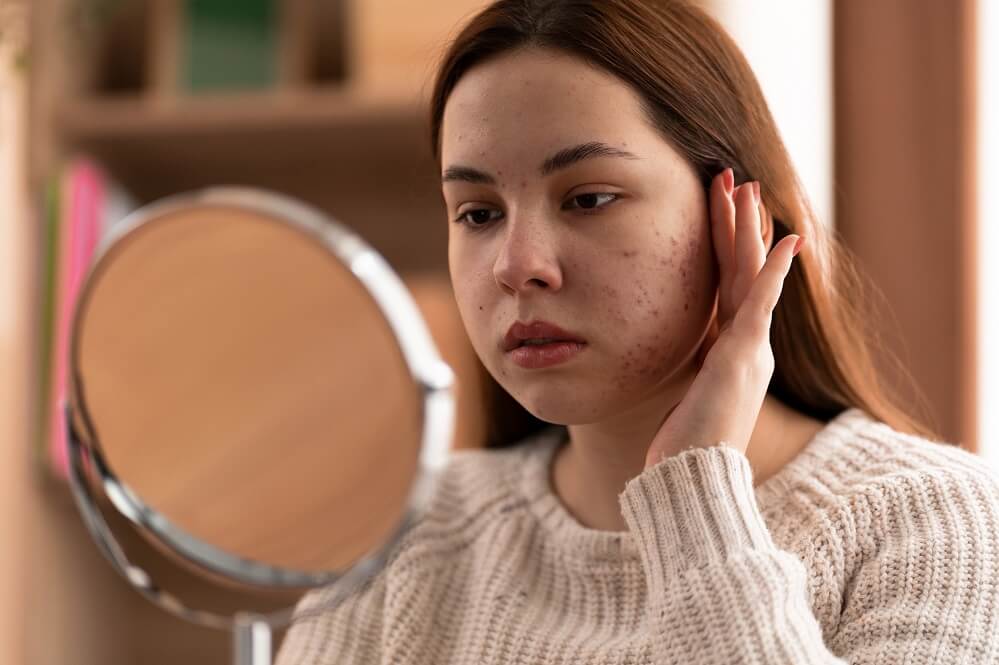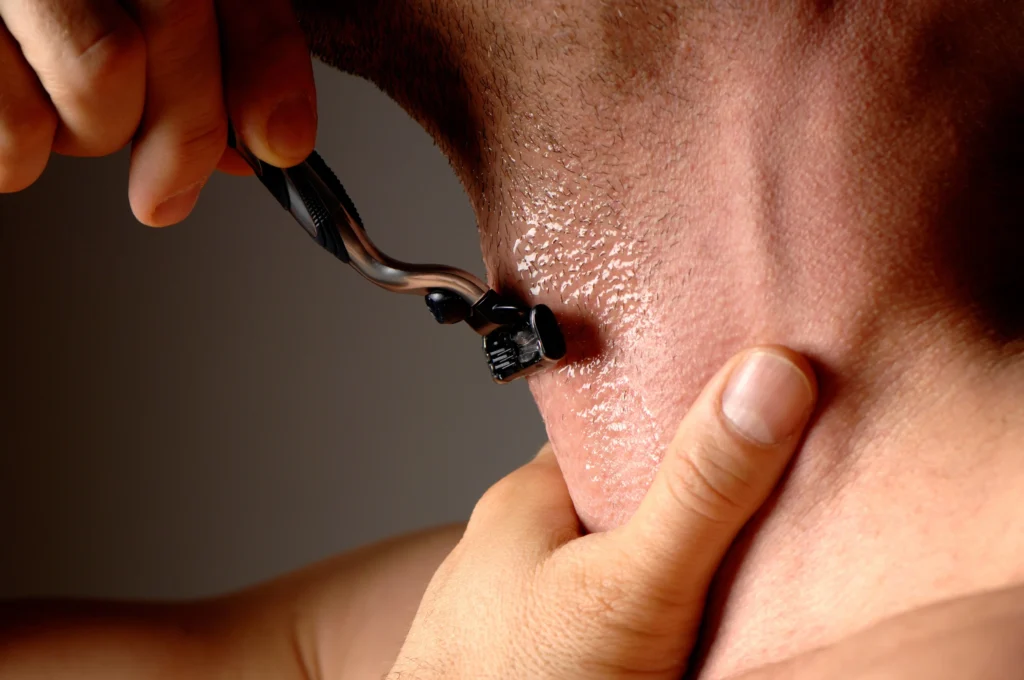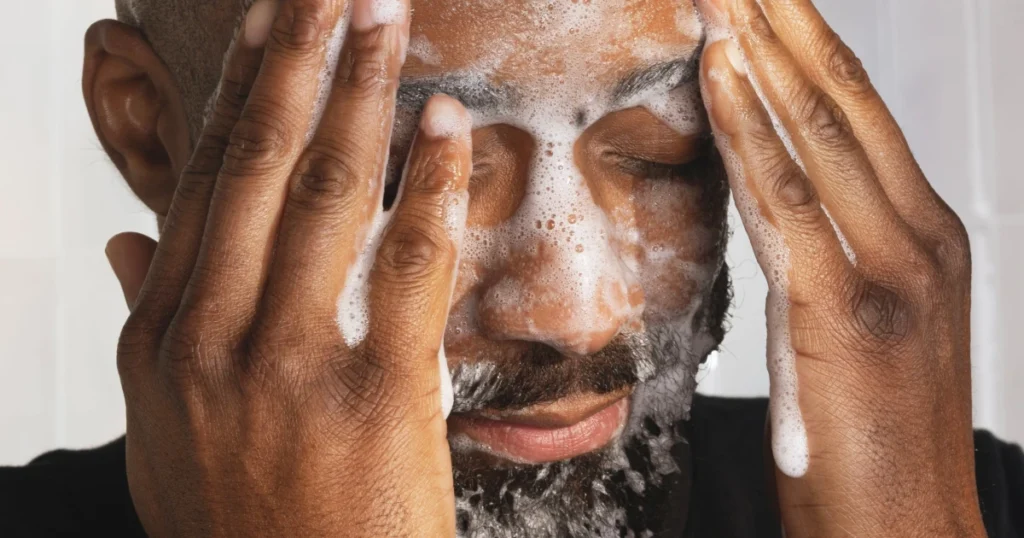Dark skin or hyperpigmentation can sometimes appear after shaving. Many people notice dark spots, patches, or uneven skin tone on areas where they shave frequently. This often happens because shaving can irritate the skin, cause small cuts, or trigger razor burns, which leads the skin to produce extra pigment as a protective response. People with darker skin tones or sensitive skin are more prone to this type of pigmentation.
In this blog, we will explore how shaving can contribute to darkened skin, the common mistakes that make it worse, and practical tips for preventing and treating shaving-induced hyperpigmentation.
What Is Hyperpigmentation?
Hyperpigmentation is a common skin condition where certain areas of the skin become darker than the surrounding skin. This happens when the body produces extra melanin, the pigment responsible for skin color. It can appear as dark spots, patches, or uneven skin tone and can affect any part of the body.

There are several types of hyperpigmentation, including post-inflammatory hyperpigmentation, which occurs after skin irritation or injury, sun-induced pigmentation caused by prolonged sun exposure, and hormonal changes that trigger dark spots. Understanding what causes hyperpigmentation is the first step in preventing and treating it, especially when it is linked to everyday habits like shaving.
Recommended: Why is My Scrotum Darker Than My Skin Even Though it Has Never Seen The Sun?
Common Causes of Hyperpigmentation
Hyperpigmentation can be triggered by several factors that cause the skin to produce excess melanin. Some of the most common causes include:
- Post-inflammatory hyperpigmentation: This happens when the skin darkens after inflammation or injury such as acne, cuts, burns, or frequent shaving.
- Sun exposure: Prolonged exposure to the sun increases melanin production, leading to dark spots and uneven skin tone.
- Hormonal changes: Pregnancy, birth control, or hormonal imbalances can cause melasma, a type of hyperpigmentation.
- Genetics: Some people are naturally more prone to developing dark spots due to their skin type or family history.
- Certain medications: Some drugs, like antibiotics or chemotherapy medications, can cause pigmentation changes as a side effect.
- Skin conditions: Chronic skin issues such as eczema or psoriasis can also lead to darkened areas once the skin heals.
How Shaving Affects Your Skin
Shaving is a common method of hair removal that can leave your skin feeling smooth, but it can also cause irritation if not done carefully. The friction from the razor blade can create tiny cuts, nicks, or razor burns. These minor injuries may seem harmless at first, but they can trigger the skin’s natural defense mechanism, leading to increased melanin production and the formation of dark spots over time.
The way shaving affects the skin can also depend on your skin type and hair texture. People with sensitive skin or darker skin tones are more prone to developing post-inflammatory hyperpigmentation, where the skin darkens after even minor irritation. Aggressive shaving, using a dull blade, or skipping lubrication and moisturization can worsen these effects, making dark spots more noticeable.
Recommended: Can You Bleach Your Vagina?
Proper shaving techniques and post-shave care can help reduce the risk of hyperpigmentation. Preparing the skin with warm water, using a sharp razor, shaving in the direction of hair growth, and applying a soothing moisturizer afterward can protect the skin and minimize irritation. By understanding how shaving impacts your skin, you can maintain smooth and healthy skin while preventing dark patches from forming.
Can You Get Dark Skin (Hyperpigmentation) from Shaving?
Yes, shaving can sometimes lead to dark skin or hyperpigmentation, especially if the skin is irritated during the process. When you shave, tiny cuts, nicks, and razor burns can occur. These minor injuries trigger the skin’s healing response, which may include producing extra melanin. This overproduction of pigment can result in dark spots or patches in the areas that are shaved frequently.

People with darker or more sensitive skin are particularly prone to this type of pigmentation, known as post-inflammatory hyperpigmentation. Even minor irritation from shaving can leave the skin darker than its natural tone if proper care is not taken. The way you shave, such as using a dull razor, shaving too often, or applying too much pressure, can increase the likelihood of developing these dark patches.
Fortunately, hyperpigmentation caused by shaving is preventable and often treatable. Using proper shaving techniques, moisturizing the skin afterward, and protecting it from sun exposure can reduce the risk of dark spots. For areas already affected, gentle exfoliation, topical treatments like vitamin C or niacinamide, and patience can help even out the skin tone over time. By taking care during and after shaving, you can maintain healthy, smooth skin without unwanted discoloration.
Recommended: Can Taking Testosterone Make You Sterile?
Common Mistakes That Cause Darkening After Shaving
Shaving can sometimes lead to dark spots or hyperpigmentation if certain mistakes are made. Here are some of the most common errors and why they contribute to darkening:
Using a Dull Razor
A dull blade does not cut hair cleanly and instead pulls or tugs at it. This increases friction on the skin and can cause irritation, tiny cuts, or razor burns. Over time, repeated irritation can trigger excess melanin production, leading to dark patches.
Shaving Too Aggressively or Too Often
Applying too much pressure while shaving or shaving the same area repeatedly can damage the skin. This can result in inflammation and post-inflammatory hyperpigmentation, especially in people with sensitive or darker skin tones.
Skipping Proper Skin Preparation and Aftercare
Shaving without softening the skin with warm water or a shaving cream, or failing to moisturize afterward, can leave the skin dry and irritated. Additionally, not protecting shaved areas from sun exposure can make pigmentation worse. Proper preparation and post-shave care help reduce irritation and prevent dark spots.
By avoiding these common mistakes, you can minimize the risk of hyperpigmentation and maintain smooth, even-toned skin.
Preventing Dark Spots from Shaving
Dark spots or hyperpigmentation from shaving can often be prevented by adopting the right techniques and skincare habits. Here are some effective ways to protect your skin:
- Use a sharp razor: A sharp blade cuts hair cleanly without tugging or pulling at the skin. Replacing your razor regularly reduces friction and irritation, lowering the risk of dark spots forming.
- Shave gently and in the direction of hair growth: Applying light pressure and shaving in the direction your hair grows minimizes irritation. Avoid going over the same area multiple times, as repeated friction can trigger pigmentation.
- Prepare your skin before shaving: Soften your skin and hair with warm water and a gentle shaving cream or gel. This reduces friction and makes the shave smoother, decreasing the chance of cuts, razor burns, and dark spots.
- Moisturize and soothe your skin afterward: After shaving, use a moisturizer or soothing lotion to calm the skin and maintain hydration. This helps prevent dryness and irritation, which can contribute to hyperpigmentation.
- Protect your skin from the sun: Sun exposure can worsen dark spots on freshly shaved skin. Apply sunscreen to shaved areas or cover them when outdoors to prevent pigmentation from increasing.
By following these steps consistently, you can enjoy smooth, healthy skin while reducing the likelihood of shaving-related dark spots.
Treatment Options for Shaving-Induced Hyperpigmentation
If dark spots develop after shaving, there are several effective treatment options to help even out your skin tone. Here are some ways to manage and reduce shaving-induced hyperpigmentation:
1. Topical Treatments
Using creams or serums that contain ingredients like vitamin C, niacinamide, or kojic acid can help lighten dark spots over time. These ingredients work by reducing melanin production and promoting a more even skin tone.
Recommended: Best Underwear After a Vasectomy: Top 5 Types
2. Gentle Exfoliation

Regular exfoliation with mild scrubs or chemical exfoliants, such as alpha-hydroxy acids (AHAs) or beta-hydroxy acids (BHAs), can remove dead skin cells and improve the appearance of dark patches. Avoid harsh scrubbing, as it can worsen irritation and pigmentation.
3. Professional Treatments
For persistent or severe hyperpigmentation, dermatologists may recommend chemical peels, microdermabrasion, or laser treatments. These procedures can effectively reduce dark spots and promote smoother, more even skin.
4. Sun Protection
Applying sunscreen to affected areas is crucial while treating hyperpigmentation. UV exposure can worsen dark spots and slow down the healing process. Using SPF 30 or higher daily helps protect the skin and maintain treatment results.
5. Patience and Consistency
Hyperpigmentation can take time to fade, sometimes several weeks or months. Consistent skincare, gentle shaving habits, and proper sun protection are key to seeing results.
By combining these treatments with careful shaving techniques, you can significantly reduce dark spots and maintain healthy, even-toned skin.
Conclusion
Dark skin or hyperpigmentation from shaving is a common concern, but it can be prevented and treated with the right approach. Understanding how shaving affects your skin, avoiding common mistakes, and following proper shaving techniques can help minimize irritation and reduce the risk of dark spots.
In addition, consistent skincare, including moisturizing, gentle exfoliation, and sun protection, plays a key role in maintaining even-toned, healthy skin. For persistent hyperpigmentation, topical treatments or professional dermatological procedures can help restore your natural skin tone.
By combining careful shaving habits with proper skin care and patience, you can enjoy smooth, radiant skin without the worry of dark patches. Taking these steps ensures that shaving remains a safe and effective way to maintain your skin’s health and appearance.
